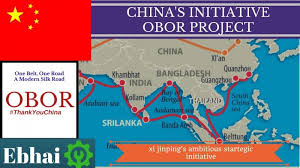IMPLEMENTASI KONSEP KEBIJAKAN ONE BELT ONE ROAD (OBOR) CHINA DALAM KERANGKA KERJASAMA PEMBANGUNAN INFRASTUKTUR DI INDONESIA
DOI:
https://doi.org/10.25299/jdis.2019.vol2(02).5138Keywords:
OBOR, Xi Jinping, New Silk Road, infrastructure.Abstract
This article discusses the One Belt One Road OBOR Initiative launched by Xi Jinping in 2013, focusing on the role of the initiative in realizing Zhongguomeng. The OBOR initiative is a new infrastructure development project that uses the concept of the New Silk Road that covers geopolitical and geo-economic aspects to connect the Eurasian region with China as its center. The author begins the research by interpreting the background that prompted the Chinese government to implement the OBOR Initiative using historical approaches and qualitative studies, then analyzing the extent to which the OBOR policy can be useful for Xi Jinping to achieve the Zhongguomeng target. The Silk Road was later promoted to become China's new slogan in various international forums. In the view of the current Chinese leader, the concept of the New Silk Road is also known as the "One Belt One Road". China then added another concept, the 21st Century Maritime Silk Road which was seen as an effort to strengthen relations with countries in South and Southeast Asia including one with Indonesia which focused on maritime trade and acceleration. infrastructure development in order to increase economic growth. The results show that the OBOR Initiative has a role as a tool to realize Zhongguomeng through the development of infrastructure that supports the flow of industrial trade, provides a unifying platform for China, and global peace cooperation relations. Indonesia as a developing country is one of the OBOR member countries to improve its economy. In its implementation, infrastructure cooperation between the two countries continues to increase which has a significant impact on Indonesia's infrastructure development, although it cannot be denied that there are many obstacles that need to be faced
Downloads
References
Ferdinand, Peter. Westward ho—the China dream and ‘one belt, one road’: Chinese foreign policy under Xi Jinping. International Affairs 92: 4, 2016.
Lingliang, Zeng. Conceptual Analysis of China’s Belt and Road Initiative: A Road towards a Regional Community of Common Destiny. Chinese Journal of International Law, 2016,
Shicun, W. dan Keyuan, Z. Ed. 2009. Maritime Security in the South Tiongkok Sea: Regional Implications and International Cooperation. Surrey, UK: Ashgate.
Najamuddin Khairur Rijal. 2019. Smart Maritime Diplomacy: Diplomasi Maritim Indonesia Menuju Poros Maritim Dunia. Universitas Muhammadiyah Malang, Indonsia.
Yakti, Probo Darono, and Joko Susanto. 2017. “Poros Maritim Dunia Sebagai Pendekatan Strategi Maritim Indonesia: Antara Perubahan Atau Kesinambungan Strategi ?” Global & Strategis 11 (2): 108–25. doi:10.20473/jgs.v11i2.5355.
Buku
James C F. Wang, Contemporary Chinese Politics : An Introductions, Penyunting Nur Raclimal Yuliantoro (Yogyakarta:UGM, 2000)
Robert Jackson dan George Sorensen, Pengantar Studi Hubungan Internasional, terj. Dadan Suryadipura (Yogyakarta: Pustaka Pelajar, 2009)
Hubungan Indonesia-Cina Dalam Dinamika Politik, Pertahanan-Keamanan, dan Ekonomi di Asia Tenggara (p. 153). Jakarta: LIPI Press.
David Murphy. One Belt One Road: International Development Finance Withchinese Characteristics dalam Pollution (Canberra: ANU Press, 2016)
C. Fred Bergsten, et al. China’s Rise: Challenges and Opportunities (Washington, DC: Peterson Institute For International Economics Center For Strategic and International Studies, 2008)
Diplomasi Indonesia dan Pembangunan Konektivitas Maritim, Humphrey Wangke, Edisi 1, (Jakarta: Yayasan Pustaka Obor Indonesia, 2018)
Ganewati Wuryandari, “Enam Dekade Politik Luar Negeri Indonesia: Sebuah Catatan yang Terlewat”, dalam Ganewati Wuryandari (eds.), Politik Luar Negeri Indonesia di Tengah Pusaran Politik Domestik, P2P LIPI dan Pustaka Pelajar, Yogyakarta, 2008.
Suropati, Untung, Yohanes Sulaiman, and Ian Montratama. 2016. Arungi Samudera Bersama Sang Naga: Sinergi Poros Maritim Dunia Dan Jalur Sutra Maritim Abad Ke-21. Jakarta: Elex Media Komputindo.S
John Wong, “Reviving the Ancient Silk Road: China’s New Economic Diplomacy”, East Asian Policy, Singapore: East-Asian Institute, 2014.
Nazir. Metode Penelitian. (Jakarta: Rineka Cipta, 1998)
Sugiyono. Metode Penelitian Kuantitatif Kualitatif dan R&D (Bandung: Alfabeta, 2012).
Website
https://en.imsilkroad.com/p/80863.html
https://www.cnbcindonesia.com/news/20190513181838-4-72178/apa-itu-obor-jalur-sutra-modern-china-yang-jadi-polemik-ri
https://www.kompasiana.com/muhammadfahrulrozzi7860/5b37b76e16835f7e52226c92/one-belt-one-road-untuk-indonesia?page=all
https://news.detik.com/kolom/d-4709274/poros-maritim-dunia-dan-kemitraan-strategis-indonesia-china
http://www.indonesiabriefing.com/news/indonesia-targets-maritime-obor-investment-push
https://legal.un.org/avl/ha/uncls/uncls.html
https://nasional.kompas.com/read/2019/08/07/07214581/poros-maritim-dunia-potensi-indonesia-miliki-model-diplomatik-unik?page=all







